https://triblive.com/opinion/paul-kengor-threat-of-nuclear-war-october-1962-and-2022/
Paul Kengor: Threat of nuclear war, October 1962 and 2022

“It shall be the policy of this nation to regard any nuclear missile launched from Cuba against any nation in the Western Hemisphere as an attack by the Soviet Union on the United States,” said President John F. Kennedy in a dramatic nationally televised speech on Oct. 22, 1962, “requiring a full retaliatory response upon the Soviet Union.”
Americans knew what that meant. A full retaliatory nuclear response upon the Soviet Union, and vice versa — the Soviet Union upon the United States — meant nuclear Armageddon.
Americans dashed to grocery stores to buy canned food and supplies, and many literally started digging bomb shelters.
It was a grim scenario, one that terrified all of humanity, from Washington to Moscow to every capital. But there were two extraordinary exceptions: Fidel Castro and Che Guevara.
“If the nuclear missiles had remained, we would have fired them against the heart of the U.S., including New York City,” Che gleefully admitted in November 1962 to Sam Russell of Britain’s Daily Worker. “The victory of socialism is well worth millions of atomic victims.”
Che was an unhinged zealot, as was Fidel Castro.
Castro actually recommended to Soviet General Secretary Nikita Khrushchev that they together launch an all-out nuclear attack upon the United States. He candidly spoke about it 30 years later during a conference in Havana. Robert McNamara, President Kennedy’s secretary of defense during the Cuban Missile Crisis, was taken aback by Castro’s candid admission, as Fidel looked him in the eye and said, almost casually: “Bob, I did recommend they (the nuclear missiles) were to be used.”
In total, said McNamara, there were 162 Soviet missiles on the island. The firing of those missiles alone would have led to (according to McNamara) at least 80 million dead Americans.
That, however, is a mere conservative estimate, given that 162 missiles were far from the sum total that would have been subsequently launched. The United States in turn would have launched on Cuba and also on the USSR. In response, of course, the Soviets would have launched on America. The fireworks would just be starting: Under the terms of their NATO and Warsaw Pact charters, the territories of Western and Eastern Europe would also start firing.
Once the smoke cleared, hundreds of millions to possibly over a billion people could have perished.
When he learned of his Cuban pals’ fanaticism, Khrushchev acted without hesitation to get the nukes away from these madmen. He met with top officials in the “code room” of the Soviet Foreign Ministry very late on a Sunday night, and ordered, repeatedly, “Remove them, and as quickly as possible.”
Mercifully, the world averted nuclear war.
It is ironic and scary that 60 years after the Cuban Missile Crisis, President Joe Biden is warning of possible nuclear “Armageddon,” and once again with Russia.
Personally, I believe the potential for a desperate Vladimir Putin to escalate to the level of using nuclear weapons is frighteningly real. The Soviet leaders in 1962 were dictators, too, but they were also sober-minded men who did not want nuclear war. Putin has shown in Ukraine that he is utterly ruthless.
In the fall of 2022, the threat of nuclear war again hinges on the man in the Kremlin. What will he choose?
Copyright ©2025— Trib Total Media, LLC (TribLIVE.com)
